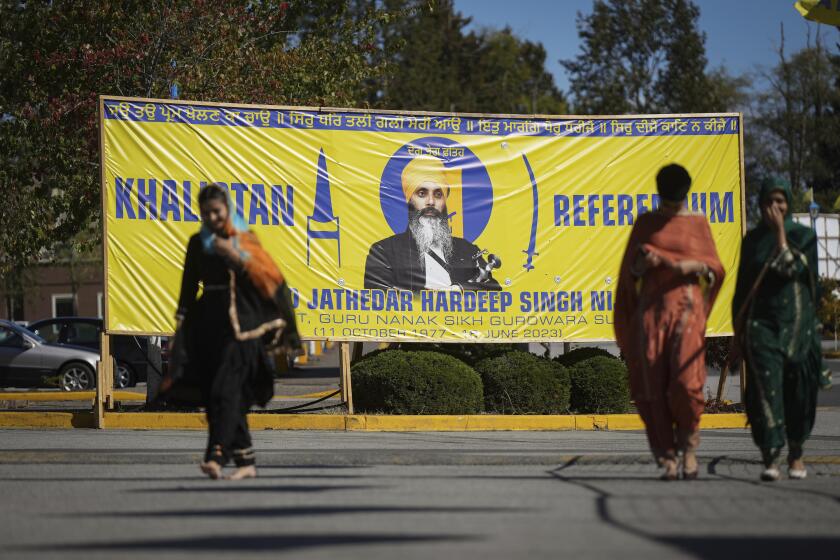Messengers Share Pain of Loss
After Army Pfc. Joel K. Brattain was killed by a roadside bomb in Baghdad a year ago, the painful task of notifying his family got underway thousands of miles from his hometown of Yorba Linda.
Officers from Brattain’s unit in Iraq, the 82nd Airborne Division, contacted their rear detachment at Ft. Bragg, the division’s home base. A soldier here alerted the post casualty assistance center, which then telephoned the Army base nearest to Yorba Linda -- Ft. Irwin.
There, Sgt. Lloyd Cook, who had never heard of Brattain, answered his cellphone at home on a quiet Sunday morning and was ordered to tell a stranger that his son was dead.
There was no military chaplain available to help Cook deliver the news to Brattain’s father, Gary Brattain. He would have to do it alone. It was his first time. He felt a wave of anxiety.
“I mean, telling someone their loved one is gone -- that’s hard,” Cook recalled. “I wasn’t sure how to do it.”
The ritual that played out later that day in Gary Brattain’s living room, with Cook in his dress uniform struggling to get the words out, is repeated virtually every day somewhere in the United States. At least 1,571 U.S. troops have been killed in Iraq. And casualty notification officers are knocking on doors and delivering staggering news to families across America as the war enters its third year.
The choreographed visits trigger overwhelming shock and grief for spouses and children, parents and siblings. But death notifications are also searing emotional experiences for those charged with delivering the news.
Notification officers are not trained grief counselors or, for the most part, veterans of previous notifications. They are ordinary soldiers whose sudden call to notification duty is difficult and draining in its own way.
“They feel inadequate -- they don’t know what to say,” said Capt. Christopher Dickey, 33, a soft-spoken Ft. Bragg chaplain who presided at Brattain’s funeral. “I tell them that just their being there communicates more than they could ever put into words.”
Before driving two-and-a-half hours to Gary Brattain’s home in Brea, Cook stopped at the Ft. Irwin casualty assistance office, where he was told the details of the death of Brattain, 21. But nothing, he said, could have fully prepared him to knock on someone’s door and tell him his child is dead.
“It was a very emotional experience,” Cook said. “There’s no easy way to do it. I tried not to sugarcoat it -- but to say that I sympathized with his loss.”
Gary Brattain made it easier. He had already learned of his son’s death from his former wife, who had been notified earlier that day.
He knew Cook was coming.
“Mr. Brattain tried to make me feel comfortable,” Cook said. “He actually thanked me.”
Even so, Cook was required to make a formal notification. “On behalf of the secretary of Defense, I regret to inform you ... “ he began, and then briefly related the circumstances of Brattain’s death.
Cook has since performed three more death notifications. Before and after each visit, he had a heartfelt talk with his father, a church deacon.
“I want to make sure I’m doing the right thing,” he said. “Basically, I try to tell them how I feel from my heart.”
The Army’s death notification process is built on an intricately prescribed routine. But for all of its formality and military rigidity, the ritual can be surprisingly heartfelt and almost tender.
“So much of what they did turned out to be so comforting, and so caring,” Gary Brattain said. “Given what they’re dealing with, the process is probably as good as it can get.”
The Army says it tries to deliver the news of a death as quickly as possible, preferably within hours. Speed is essential in a war in which troops have access to the Internet and satellite phones. (Field commanders use “kill switches” to disable communications when a unit suffers a combat death.)
If a fallen soldier’s next of kin lives near his unit’s base, a soldier from that unit is selected to deliver the news. It must be delivered face to face to the person listed as “primary next of kin” on forms filled out by all soldiers. All notifications are made between 6 a.m. and 10 p.m. The notification officer must be of equal or higher rank than the soldier who has died.
At Ft. Bragg, the base for thousands of soldiers deployed in Iraq and Afghanistan, the casualty assistance center never closes. Soldiers selected for notification duty are rushed to the center, where they are given a briefing that includes a short video, pamphlets and a checklist.
Notifying officers are told the time and place of a soldier’s death, along with basic details of the incident. They are told not to provide any other information.
They are instructed to verify the next of- kin’s identity by asking his or her name. The news should be delivered inside the home. In most cases, a notification soldier is accompanied by a chaplain, but the news must be delivered by the soldier.
Soldiers are told to follow a format that includes an expression of regret from the secretary of Defense. They are encouraged to offer their own brief condolences.
Although most soldiers make only one death notification during their careers, chaplains often make repeated visits.
“Your main mission is just to be present, offer comfort, have them see the uniform,” Dickey said. “It’s a presence, a reaffirmation that in the darkest times, God is with us. We are there to help them begin the process of grieving.”
In recent years, the Army has created “comfort teams” made up of spouses of soldiers deployed overseas. Working with chaplains, the teams arrange to visit grieving family members in the hours immediately after notification.
Most people react predictably -- with shock, disbelief and tears, said Joyce L. Land, who runs the casualty assistance center at Ft. Bragg. A few respond with anger or hostility toward the military, she said.
“Normally, you stay as long as necessary to try to console the family,” Land said. “If they take it badly, you might have to get in and get out smartly. If the person is extremely angry or violent, you remove yourself from the situation -- and in certain cases, notify law enforcement.”
Face-to-face death notifications did not begin until the Vietnam War. During World Wars I and II, families were for the most part notified by telegrams, usually several days -- and sometimes weeks -- after the death.
After Brattain died on March 13, 2004, two notification officers were required because his parents had divorced. The private’s wife, Andrea Brattain, 21, was living in Yorba Linda with his mother, Elaine Roach Clark.
The paratrooper had designated his wife as primary next of kin, so she had to be notified first. Only then could his parents be told.
But Clark knew the instant she saw two soldiers in dress uniform on her doorstep that her son was dead. When she was 8, in 1964, a soldier in dress uniform had come to her house with the news that her father, a Navy pilot, had died in Vietnam.
This time, Clark begged the soldiers to tell her what had happened, she recalled. Following protocol, they told her: “We need to speak to Andrea.”
The soldiers waited in Clark’s living room while she phoned her daughter-in-law, who was shopping for a dress to wear for her husband’s return home in two weeks. Clark recalled struggling to control her grief and shock.
“I told Andrea I needed the car and she had to come home right away,” she said.
Andrea said the pained tone of her mother-in-law’s voice made her think she had done something wrong. “I kept wondering what I had done to upset her so much,” she recalled.
When she arrived at Clark’s home, she thought the officers had brought her husband with them -- that he was hiding, ready to leap out and surprise her.
But her mother-in-law, in tears, took her hand and said: “Andrea, you need to sit down.” She guided her to a chair.
Andrea said she remembered the officer telling her that Joel was dead, but recalled little of what happened afterward. She thought she might have asked, “Was it quick?”
“I was in a numb state,” she said. “I couldn’t comprehend anything. My mind wouldn’t let me absorb anything that wasn’t good news.”
The officers were formal but polite, she said. “I think they realized that I wasn’t responding to them. They left pretty quickly. There really wasn’t anything more they could say.”
A year later, Andrea does not recall the names of the notification officer and the chaplain. But she remains close to Sgt. David L. Blair, her casualty assistance officer.
While notification officers typically spend less than an hour with families, assistance officers can spend months. Their job is to shepherd survivors through the Pentagon bureaucracy. They help with survivors’ payments, Social Security and Veterans Administration benefits, wills, back pay and other details.
Blair, 40, said he met with Andrea the day after she was notified. He visited the family 20 to 30 times, he said. He escorted the paratrooper’s body from the airport, helped arrange a military funeral and escorted the six-man honor detail. He cataloged Brattain’s wedding ring, watch and other personal effects and gave them to his widow.
“Sgt. Blair sat me down and took it slow,” Andrea said. “He told me it was his first time doing this, and he wanted to get it right. He went above and beyond to get whatever I needed. I’m so thankful he was there.”
Blair stays in touch with the family, taking his wife and children to meet them. He said the experience had given him new respect for the way the Army, so clumsy and counterproductive in many personnel matters, confronts death.
“It could be my family some day,” he said, “and it’s good to know there’s a system in place to take care of them.”
More to Read
Start your day right
Sign up for Essential California for news, features and recommendations from the L.A. Times and beyond in your inbox six days a week.
You may occasionally receive promotional content from the Los Angeles Times.







